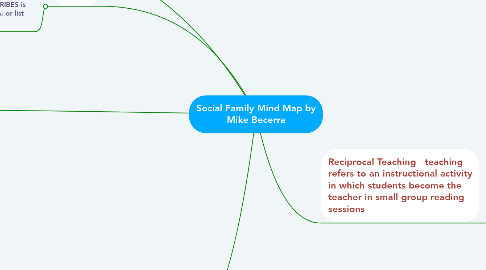
1. TRIBES is powered by a set of four agreements: 1) Attentive Listening 2) Mutual Respect 3) Right to participate/pass 4) Appreciations/ no put-downs
2. Benefits of Tribes: a) Enhances cooperation b) focuses on standards c) develops self management d) increases student achievement e) establishes a community of learners
3. Cognitive Apprenticeship
3.1. A model of instruction that goes back to apprenticeship but incorporates elements of schooling.
3.1.1. This model contains 3 stages: a) cognitive stage- develops declarative knowledge b) associative stage- shows misconceptions and creates connections c) autonomous stage- students perfect their skills
3.1.1.1. site
3.1.1.2. Benefits of Cognitive Apprenticeship: 1) encourages authentic activity and assessment. This is vital because the student is engaged in activities that are similar to real-world practices. 2) It is motivating and engaging. Students engage in authentic tasks that inspire ownership and self discovery. 3) They encourage greater levels of retention. The student practices allow for longer memory via rehearsal methods. 4) May facilitate higher order reasoning. Students benefit from the exploration of new ideas which lead to new and advanced reasoning.
4. TRIBES
4.1. A process for establishing positive discipline and learning environment where students are developing becoming skillful, resilient, and knowledgeable in their everyday learning. TRIBES is not a curriculum, program, or list of activities.
4.1.1. TRIBES is successful because students it allows students to feel safe and included in the their learning environment. This is critical as it motivates students and allows them to reach higher-order thinking skills.
5. Reciprocal Teaching teaching refers to an instructional activity in which students become the teacher in small group reading sessions
5.1. Strategies for teaching this concept include: summarizing, question generating, clarifying, and predicting.
5.2. The Reciprocal Learning Strategy
5.2.1. In the classroom setting, the students are grouped into teams of four and assigned their role by the teacher: The role of the summarizer is to identify the main idea of the text, identify key vocabulary, and summarize the key details. The role of the questioner is to ask questions to help make meaning of the text and to model a range of questions types like literal and inferential question types. The role of the clarifier is to look for unfamiliar words and phrases, identify complex ideas or concepts, and work with the group to find meaning. The role of the predictor is to suggest what the next events in the conversation will be, to use clues for the ensuing conversations, and to share predictions and evidence with the group.

